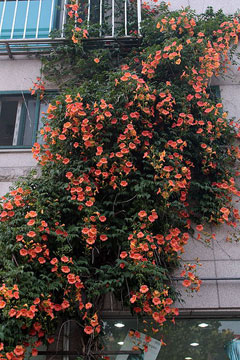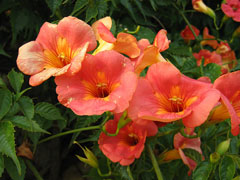 |
|
http://commons.wikimedia.org/wiki/User:Dalgial |
 |
| http://commons.wikimedia.org/wiki/User:Solipsist |
Translate this page:
Summary
Physical Characteristics

 Campsis is a deciduous Climber growing to 9 m (29ft 6in) at a fast rate.
Campsis is a deciduous Climber growing to 9 m (29ft 6in) at a fast rate.
See above for USDA hardiness. It is hardy to UK zone 7 and is not frost tender. It is in leaf from June to October, in flower from August to September. The species is hermaphrodite (has both male and female organs).
Suitable for: light (sandy), medium (loamy) and heavy (clay) soils and prefers well-drained soil. Suitable pH: mildly acid, neutral and basic (mildly alkaline) soils. It cannot grow in the shade. It prefers moist soil. The plant can tolerate maritime exposure.
UK Hardiness Map
US Hardiness Map
Synonyms
C. adrepens. C. chinensis. Voss. Bignonia chinensis. B. grandiflora. Tecoma grandiflora.
Plant Habitats
Edible Uses
References More on Edible Uses
Medicinal Uses
Plants For A Future can not take any responsibility for any adverse effects from the use of plants. Always seek advice from a professional before using a plant medicinally.
The flowers and the whole plant are blood tonic, carminative, depurative diuretic and febrifuge[147, 178, 218]. They are used in the treatment of women's complaints[147, 178]. A decoction of the flowers is used to correct menstrual disorders, rheumatoid pains, traumatic injuries, difficult urination, pruritis and oozing dermaphytoses[147, 218].
References More on Medicinal Uses
The Bookshop: Edible Plant Books
Our Latest books on Perennial Plants For Food Forests and Permaculture Gardens in paperback or digital formats.

Edible Tropical Plants
Food Forest Plants for Hotter Conditions: 250+ Plants For Tropical Food Forests & Permaculture Gardens.
More

Edible Temperate Plants
Plants for Your Food Forest: 500 Plants for Temperate Food Forests & Permaculture Gardens.
More

More Books
PFAF have eight books available in paperback and digital formats. Browse the shop for more information.
Shop Now
Other Uses
Plants can be allowed to scramble on the ground and will form an effective ground cover, rooting at intervals along the branches[208]. They should be planted about 2.5 metres apart each way[208].
Special Uses
References More on Other Uses
Cultivation details
Succeeds in a good well-drained loam[11, 200] and a very sunny position[166] or light shade[200]. Tolerates moderately alkaline or moderately acid soils[202]. Dormant plants are hardy to about -10°c[200], though they require a sunny sheltered wall or hot summers if they are to flower well[11, 166]. The fresh young growth in spring is often damaged by late frosts[208]. Plants can take some years to settle down before they start to flower[202]. They climb by means of aerial roots but need to be supported[11, 166]. Another report says that this species does not produce aerial roots[219]. Plants can be pruned like grapes (Vitis spp.)[11] and any pruning is best done in the spring[188]. The sub-species C. grandiflora thunbergii tolerates saline winds[200]. Hybridizes freely with other members of this genus[200].
References Carbon Farming Information and Carbon Sequestration Information
Temperature Converter
Type a value in the Celsius field to convert the value to Fahrenheit:
Fahrenheit:
The PFAF Bookshop
Plants For A Future have a number of books available in paperback and digital form. Book titles include Edible Plants, Edible Perennials, Edible Trees,Edible Shrubs, Woodland Gardening, and Temperate Food Forest Plants. Our new book is Food Forest Plants For Hotter Conditions (Tropical and Sub-Tropical).
Shop Now
Plant Propagation
Seed - sow spring in a greenhouse at 10°c. Two months stratification at 5°c assists germination[200]. When they are large enough to handle, prick the seedlings out into individual pots and grow them on in a greenhouse for at least their first winter. Plant them out into their permanent positions in late spring or early summer, after the last expected frosts. Cuttings of almost ripe wood, 7 - 10cm long, July/August in a frame. Slow to root but a fair percentage[78, 200]. Root cuttings 5cm long in December. Fair to good percentage[78]. Division of suckers in the dormant season[202]. Layering in winter[188]. Plants often self-layer[260].
Other Names
If available other names are mentioned here
Native Range
TEMPERATE ASIA: China (Fujian Sheng, Guangdong Sheng, Guangxi Zhuangzu Zizhiqu, Hebei Sheng, Shandong Sheng, Shanxi Sheng)
Weed Potential
Right plant wrong place. We are currently updating this section.
Please note that a plant may be invasive in one area but may not in your area so it's worth checking.
Conservation Status
IUCN Red List of Threatened Plants Status :

Growth: S = slow M = medium F = fast. Soil: L = light (sandy) M = medium H = heavy (clay). pH: A = acid N = neutral B = basic (alkaline). Shade: F = full shade S = semi-shade N = no shade. Moisture: D = dry M = Moist We = wet Wa = water.
Now available:
Food Forest Plants for Mediterranean Conditions
350+ Perennial Plants For Mediterranean and Drier Food Forests and Permaculture Gardens.
[Paperback and eBook]
This is the third in Plants For A Future's series of plant guides for food forests tailored to
specific climate zones. Following volumes on temperate and tropical ecosystems, this book focuses
on species suited to Mediterranean conditions—regions with hot, dry summers and cool, wet winters,
often facing the added challenge of climate change.
Read More
Expert comment
Author
(Thunb.)K.Schum.
Botanical References
11200266
Links / References
For a list of references used on this page please go here
Readers comment
| Add a comment |
|
If you have important information about this plant that may help other users please add a comment or link below. Only comments or links that are felt to be directly relevant to a plant will be included. If you think a comment/link or information contained on this page is inaccurate or misleading we would welcome your feedback at [email protected]. If you have questions about a plant please use the Forum on this website as we do not have the resources to answer questions ourselves.
* Please note: the comments by website users are not necessarily those held by PFAF and may give misleading or inaccurate information.
To leave a comment please Register or login here All comments need to be approved so will not appear immediately.
|
|